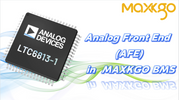
What is the Analog Front End (AFE)?
, by MAXKGO COMPANY, 6 min reading time

, by MAXKGO COMPANY, 6 min reading time
The Battery Management System (BMS) is like the "brain" of a lithium-ion battery pack. It oversees and coordinates each battery cell within the group to ensure safe and efficient operation.
A BMS has several important parts. These include a battery management chip (BMIC), an Analog Front End (AFE), an embedded microprocessor, and software. The software analyzes data in real time.
With this data, the BMS provides protection through voltage, temperature, short circuit, and overcurrent safeguards, among others. It also balances voltage across cells and enables data communication.
The analog front end (AFE) is a key component in BMS, especially in battery management AFE. This monitoring chip has multiple sampling channels and can monitor voltage and temperature to keep the battery healthy.
In the AFE circuit, parts like a 16-bit ADC, a high-precision voltage reference, and a multiplexer work together. They help provide accurate measurements.
Electric vehicles and high-voltage mobile devices commonly use AFE. You’ll also find it in backup battery systems and high-voltage data acquisition systems. AFE plays a key role in analog signal processing and signal conditioning in these devices.

AFE chips play an important role in checking battery health (BMS). They provide very accurate data on cell voltage and temperature.
This precision is important for finding problems like cell imbalance or overheating. These issues can lower battery efficiency and shorten its life. The battery management AFE also allows for real-time adjustments. This ensures each cell works within safe limits.
AFE focuses on analog signal conditioning. It prepares data for digital processing.
In contrast, Digital Signal Processing (DSP) works with data that is already in digital form. AFEs boost and filter analog signals to reduce distortion and improve clarity.
In contrast, DSP examines the digital data to perform tasks like compression, filtering, and modulation. Together, these systems ensure precise monitoring and management in applications ranging from battery monitoring AFEs to communication systems.
In signal processing, AFEs offer benefits like high accuracy and less noise interference. These features are important for reliable analog-to-digital conversions.
Since analog signals can often be weak or unstable, an AFE optimizes these signals for more accurate digital processing.
AFE circuits are small and use less energy. This makes them great for high-performance electronics, such as BMS and sensor applications.
AFE monitors help battery management systems assess critical data for better decision-making in battery protection. The data processed includes analog-to-digital conversion from cells, amplifying and filtering signals as part of signal processing. This keeps battery packs safe by maintaining a balanced voltage and prevents cell degradation over time.
The analog front end (AFE) is a key part of sensor circuits. It amplifies and filters sensor signals. These signals are often weak and can have complex electrical setups for different MCUs. Its purpose is to process the analog signal given by the signal source, digitize and analyze it.
The main functions of AFE are signal amplification, filtering, receiving ADC, and frequency conversion. It also handles adjacent frequency processing and level adjustment.
Many areas, including communication, automobiles, medicine, smart devices, and consumer electronics, use AFE. In recent years, the AFE market has been improving. This change is because of the growth of downstream industries. The market is moving towards smaller sizes, higher integration, and multiple channels.
Globally, core analog front-end (AFE) manufacturers mainly include Analog Devices, Inc. (ADI), Texas Instruments, Microchip Technology, ST Microelectronics, Cirrus Logic, and NXP. In 2021, the top echelon manufacturers are mainly ADI and TI. Together, they hold about 60% of the market share.

MAXKGO uses ADI’s LTC6813 for its Smart BMS systems, ensuring high precision and reliability for users. People recognize the LTC6813 for its high sampling precision and passive balancing. It also has strong temperature endurance. These features make it ideal for battery monitoring AFEs in electric vehicles and high-performance applications.

Taking Smart BMS Slave Board 18S as an example, the AFE we use is ADI's LTC6813.
Features of the ADI LTC6813 sampling chip:
Sampling range is 0V ~ 5V
Total measurement error less than 2.2mV
Use isolated serial communication
AEC-Q100 Qualified
Passive equalization can reach up to 200mA, and the chip is equipped with PWM control
There are 9 GPIO ports
eLQFP 64-pin package
112.5V withstand voltage
Operating temperature range from –40°C to 125°C
The ADI LTC6813 sampling chip has a maximum of 18 channels of cell sampling and supports daisy chain twisted pair cascading. Its basic architecture is shown in the figure below:

ADI LTC6813 chip sampling function:
The ADC in the ADI LTC6813 sampling chip gets the analog voltage signal from the external input cell. This allows the chip to perform digital processing.
The ADCV command performs sampling of the battery voltage chip C0 to C18 input
The LTC6813-1 contains 3 ADCs, and the multiplexer samples the voltage of 18 strings of cells.
The figure below shows the voltage data read by ADI’s official Linduino software host computer at room temperature. The data read by each cell is within 2mV of the actual voltage data measured by the actual cell.

ADI LTC6813 is a high-precision lithium battery cell sampling chip with up to 18 sampling channels. This series supports multi-channel sampling and has the advantages of high precision and stable communication.
All software BMS under MAXKGO use ADI's analog front-end chips. This aims to give customers a better experience and more accurate battery data.
ADI's LTC681X series monitors battery packs. It measures the individual voltages of 6, 12, 15, or 18 connected batteries.
Among them, LTC6811 can measure up to 12S, LTC6812 can measure up to 15S, and LTC6813 can measure up to 18S.
We appreciate your patience and look forward to seeing you in the next blog.
·Active vs Passive Balancing: Which is Best for Your Lithium Battery?
Please follow our social media for more info, thanks.
YouTube: https://www.youtube.com/@MAXKGO
Instagram: https://www.instagram.com/maxkgo_share/
Facebook: https://www.facebook.com/MaxkgoMall